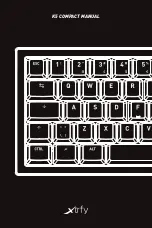
KARMA GE guide
936
Decay Time
[0…99]
The time it will take to reach the “Sustain Lev (Sustain
Level)” from the Attack Level. This is a portion of the
overall time setting specified in the “Time Scale”
parameter described below.
Sustain Level
[0…99]
The second level which the envelope reaches in the
amount of time specified by “Decay Time.” The
envelope will remain at this level until the keys
depressed on the keyboard are released, or some other
function causes the envelope to enter the Release
Phase.
Release Time
[0…99]
The time it will take to reach the “Rel. Level (Release
Level)” once the Release Phase is triggered. This is a
portion of the overall time setting specified in the
“Time Scale” parameter described below.
Release Level
[0…99]
The final level the envelope reaches in the amount of
time specified by “Rel. Time (Release Level).”
Amplitude Amount
[0…99]
Represents the maximum level that the envelope will
reach. The rest of the envelope is scaled accordingly.
For example, if this is set to
50
, the envelope’s output
will be half what the other parameter specify.
Time Scale
[0…10]
Specifies the overall amount of time that each segment
will take when set to its maximum value. The
envelopes in KARMA GE are 3 segment envelopes;
they have an attack segment, decay segment, and
release segment. For example, if the attack segment
time (“Attack time”) was set to
99
and the “Time Scale”
to
1 second
, the attack segment will take
1000 ms
; if
“Attack time” was set to
50
, then the attack segment
will take
500 ms
. If the times of all 3 segments were set
to
99
, the total time of the envelope would be
approximately 3 seconds (not taking into account any
time spent at the sustain level). When set to
0: R-Riff
Length
, the Time Scale is automatically scaled to the
length of the Generated Effect. This can be useful for
such things as harp glissandos, where supplying
more/less notes as input will cause the resulting
envelopes to be slower/faster. Note that if the Phase
“Length Mode” is set to
1: TS-Time Signature
, then
the length of a Phase is determined by the Time
Signature and not the number of notes played, so the
results of setting this to
0: R-Riff Length
may not be
noticeable in that case.
Attack Smooth
[0, 1]
When set to
0: Off
, retriggering an envelope will start
it at its preset Start Level regardless of its current
position. When set to
1: On
, the envelope will restart
from its current position, not the Start Level. This can
be used to “smooth” the repeated retriggerings of the
envelope.
Loop Mode
[0…3]
Selects one of several methods of causing the envelope
to loop continuously from one point back to another.
0: Off
The envelope will proceed through all its segments in a
normal fashion.
1: S-Start Level
↔
Sustain Level
Upon reaching the Sustain Level, the envelope will
loop back to the Start Level and start over. Requires
Envelope Latch Mode (see “Envelope Latch” on
page 109) to be set to
Off
,
Sus1
, or
Sus2
. For
continuous looping after key release, you must have
Sus2
selected - see the table below.
2: R-Start Level
↔
Release Level
Upon reaching the Release Level, the envelope will
loop back to the Start Level and start over. Requires
Envelope Latch Mode (see “Envelope Latch” on
page 109) to be set to
Rel1
or
Rel2
. For continuous
looping after key release, you must have
Rel2
selected
- see the table below.
3: A-Attack Level
↔
Release Level
Upon reaching the Release Level, the envelope will
loop back to the Attack Level and start over. Requires
Envelope Latch Mode (see “Envelope1, Envelope2,
Envelope3” on page 109, and “Envelope Latch” on
page 109) to be set to
Rel1
or
Rel2
. For continuous
looping after key release, you must have Rel2 selected -
see the table below.
The following table illustrates the relationship between
the 3 Envelope Loop Modes described above, and the
Envelope Latch Modes (see “Env1 Latch Mode” on
page 114).
0: R-Riff Length
1…10: 1 to 10 seconds in 1 second increments
0: Off
1: On
0: Off
1: S-Start Level
↔
Sustain Level
2: R-Start Level
↔
Release Level
3: A-Attack Level
↔
Release Level
Summary of Contents for Electronic Keyboard
Page 1: ...Parameter Guide Parameter Guide ...
Page 2: ......
Page 180: ...Program mode EXi 170 ...
Page 290: ...EXi STR 1 Plucked String 280 ...
Page 572: ...Sequencer mode 562 ...
Page 700: ...Global mode 690 ...
Page 751: ...Insert Effects IFX1 IFX12 Routing 741 Fig 2 3a Fig 2 3b ...
Page 902: ...Effect Guide 892 ...
















































